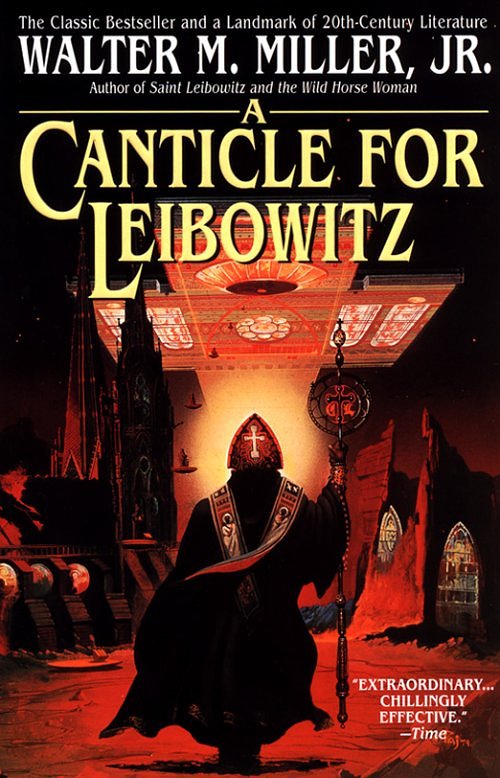|
 A
Canticle for Leibowitz was published between 1955 and 1957 in Fantasy &
Science Fiction, which along with Astounding and Galaxy was the other major
science fiction magazine of the era. Issued as a book in 1960 it won the Hugo
award for best novel. It was well received by critics and became a best
seller -- extending its appeal far beyond the regular science fiction
readership. A
Canticle for Leibowitz was published between 1955 and 1957 in Fantasy &
Science Fiction, which along with Astounding and Galaxy was the other major
science fiction magazine of the era. Issued as a book in 1960 it won the Hugo
award for best novel. It was well received by critics and became a best
seller -- extending its appeal far beyond the regular science fiction
readership.
Almost alone among post-war American science fiction
writers, Miller was preoccupied with formal religion. (The less well known James
Blish is the main exception, though Philip K. Dick and Orson Scott Card were
both deeply concerned with spiritual issues of one kind of another -- and during
the 1960s writers such as Heinlein and Herbert created large numbers of
imaginary religions and gods). Miller flew combat missions in World War II,
where he was involved in the assault on the Benedictine Monastery at Monte
Cassino. Following the war he converted to Catholicism -- at a time when many
protestant Americans still viewed the church and the pope as a somewhat sinister
foreign presence. Although he published a number of excellent and dark
short stories during the 1950s, this was the only novel he ever completed. He
was plagued by depression and killed himself a few years ago -- a sad irony
given the views expressed in the latter part of the book.
A sequel of
kinds was finished by another
writer and issued posthumously to mixed reviews.
Discussion Questions
-
What actual historical period was Miller inspired by?
What similarities are there between this historical setting and the imaginary
post-nuclear world Miller depicts? Do you find the parallels plausible?
-
There have been many depictions of nuclear war and its
aftermath, but Miller's was one of the few to meet with both critical and
popular success. What are the problems involved with writing realistically but
entertainingly on the topic, and how does Miller overcome them?
-
How would you characterize Millerís attitude toward
religion in general, and the Catholic Church in particular? Is he celebrating
it or mocking it?
-
Through the book, different characters come and go. Who
or what would you say the central character really is?
-
How does Miller depict science and progress? How does his
attitude toward these topics differs from those of the other authors whose
work we have discussed?
-
Both this book and Things to Come deal with
mankindís recovery from a devastating war. Contrast the attitudes and
assumptions of the two works. Why might they differ? How about Last and
First Men?
-
Thereís a lot of irony in the book, and a considerable
amount of humor. Would you say that its ultimate message is one of despair?
What message might Miller have wanted his readers to take away from it.
Resources
 | The Clute & Nicholls entries on Religion, Gods and Miller himself. |
 | Somebody by the name of Paul Brains at Washington State University has put
up a
pretty thorough page on the book. It includes a set of discussion
questions (some a little obvious, but you may find them helpful) plus an
explanation of the various Biblical references in the book and a translation
of all the Latin. |
|